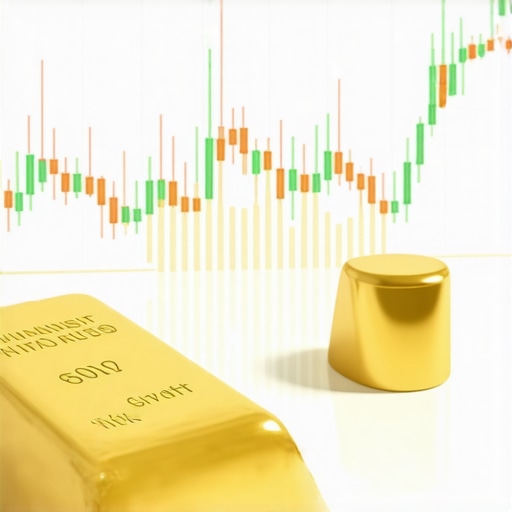Understanding the Value of Gold in 2025
As we navigate through the complexities of the financial landscape in 2025, investing in gold has emerged as a pivotal strategy for many investors. The allure of gold, often regarded as a safe haven during economic uncertainty, continues to captivate those looking to diversify their portfolios. With inflation concerns, geopolitical tensions, and fluctuating stock markets, the question arises: why should one consider gold as a key investment in 2025?
Gold’s intrinsic value is not merely a relic of the past; it plays a crucial role in modern finance. Historically, gold has served as a hedge against inflation and currency devaluation. As fiat currencies face potential instability, gold remains a tangible asset that can provide security. Additionally, central banks around the world continue to increase their gold reserves, signaling confidence in its lasting value. Understanding the dynamics of the gold market is essential for anyone considering investing in gold in 2025.
Factors Influencing Gold Prices in 2025
The gold market is influenced by various factors that can significantly impact pricing. Understanding these elements is crucial for making informed investment decisions. Key drivers include:
1. Economic Indicators
Economic growth rates, unemployment rates, and changes in interest rates can all affect gold prices. For instance, lower interest rates typically make gold more attractive as an investment, as the opportunity cost of holding gold decreases. Investors should stay informed about economic indicators and their potential impact on gold prices in 2025. Explore more about key factors influencing gold price dynamics.
2. Geopolitical Tensions
Geopolitical uncertainty often drives investors toward safe-haven assets like gold. Events such as conflicts, trade wars, or political instability can lead to increased demand for gold, pushing prices higher. Monitoring global events and their implications on the gold market is essential for anticipating price fluctuations.
3. Supply and Demand Dynamics
The balance between supply and demand significantly impacts gold prices. Factors such as mining production, central bank policies, and consumer demand in emerging markets can alter this balance. For instance, if demand from countries like China and India rises, it could lead to a surge in gold prices. Understanding these trends can help investors anticipate market movements.
4. Technological Advances
Innovations in gold extraction and processing can affect supply levels. Additionally, the rise of gold-backed cryptocurrencies and digital gold may introduce new dynamics to the market. Keeping an eye on technological advancements is vital for understanding how they might influence gold investments.
Strategies for Investing in Gold
With a solid understanding of the factors that influence gold prices, investors can examine various strategies to optimize their gold investments in 2025. One effective approach is to consider gold ETFs (Exchange-Traded Funds), which offer a convenient way to gain exposure to gold without the need to physically hold the asset. For insights on successful strategies, check out our guide on investing in gold ETFs.
Another strategy involves physical gold investments, such as coins or bullion. These tangible assets can provide peace of mind for investors seeking to secure their wealth. For first-time buyers, understanding how to navigate the gold market is crucial. Our comprehensive guide on how to buy gold smartly can help you make informed decisions.
Lastly, diversifying your investment portfolio with gold can act as a buffer against market volatility. As you consider integrating gold into your investment strategy, be aware of potential risks and rewards. The role of gold in a diversified portfolio cannot be overstated; it can stabilize returns and reduce overall risk. To delve into this topic further, explore our article on the role of gold in a diversified investment portfolio.
Understanding Different Gold Investment Vehicles
Investing in gold isn’t limited to physical bullion or coins; it encompasses a variety of investment vehicles that cater to different investor needs and preferences. Each option offers unique benefits and risks. Here, we explore the primary forms of gold investments available in 2025.
1. Physical Gold Investments
Physical gold, including bars, coins, and bullion, represents a direct investment in the metal itself. This tangible asset provides a sense of security, especially in volatile markets. Investors should consider the implications of storage, insurance, and liquidity when opting for physical gold. For a detailed guide on how to navigate the process, check out our guide on buying gold smartly.
2. Gold Exchange-Traded Funds (ETFs)
Gold ETFs have gained popularity due to their liquidity and ease of trading. These funds track the price of gold, allowing investors to gain exposure without physically holding the metal. They are particularly appealing for those looking to invest in gold without the complexities of storing it. Consider reading our article on successful strategies for investing in gold ETFs for further insights.
3. Gold Mining Stocks
Investing in gold mining companies can be another avenue for exposure to the gold market. The performance of these stocks is often correlated with gold prices, but they also come with the added risks associated with mining operations. Understanding the fundamentals of the mining sector is essential. If you’re interested in exploring this further, our post on investing in gold mining stocks provides valuable strategies and insights.
4. Gold Mutual Funds
Gold mutual funds invest in a mix of gold-related assets, including mining stocks and ETFs. This option offers diversification and professional management, making it suitable for those new to gold investing. Familiarize yourself with the pros and cons of gold mutual funds by reading our piece on the benefits of investing in gold mutual funds.
Evaluating the Risks and Rewards of Gold Investing
Like any investment, investing in gold comes with its own set of risks and rewards. It’s vital to assess these factors before committing your capital. Understanding the volatility associated with gold prices and the market’s cyclical nature will help you make informed decisions.
1. Price Volatility
Gold prices can be highly volatile, influenced by factors such as inflation rates, currency fluctuations, and geopolitical events. While gold is often seen as a safe haven, it can still experience significant price swings. For a deeper understanding of current price dynamics, refer to our analysis on gold price dynamics.
2. Market Demand
The demand for gold can fluctuate based on consumer behavior, investment trends, and industrial applications. Monitoring these demand trends is crucial for anticipating shifts in market conditions. Our post on gold demand trends offers valuable insights into what investors should watch for.
3. Currency Fluctuations
Since gold is primarily priced in U.S. dollars, fluctuations in currency values can directly impact its price. A stronger dollar often leads to lower gold prices, while a weaker dollar can boost them. Understanding these relationships can enhance your investment strategy.
Conclusion and Next Steps
With the landscape of gold investing constantly evolving in 2025, it’s crucial to stay informed and adapt your strategies accordingly. As you contemplate your next steps in gold investment, consider exploring more on the role of gold in a diversified portfolio and how it can secure your financial future. For a comprehensive overview, visit our article on the role of gold in your investment portfolio. This will guide you toward making well-rounded investment decisions that align with your financial goals.
Understanding Gold Investment Trends in 2025
As we delve deeper into 2025, understanding the prevailing gold investment trends becomes essential for informed decision-making. Investors are increasingly gravitating towards gold not only for its traditional role as a safe haven but also as a response to contemporary market dynamics. The ongoing economic shifts, including inflation and currency fluctuations, have further cemented gold’s status as a critical asset. Exploring these trends allows investors to align their strategies effectively with market realities.
The Rise of Gold as a Hedge Against Inflation
Inflation has been a persistent concern in recent years, prompting many to view gold as a reliable hedge. As central banks implement loose monetary policies, the risk of currency devaluation rises. Gold, historically seen as a safeguard against inflation, remains attractive. To learn more about how inflation impacts gold pricing, refer to our discussion on understanding gold price fluctuations.
Increasing Interest in Gold-backed Financial Products
In 2025, there is a noticeable increase in investment through gold-backed financial products, such as ETFs and certificates. These products allow investors to gain exposure to gold without the complexities of physical storage. They appeal particularly to younger investors who prefer digital solutions. For a comprehensive look at gold ETFs, check out our article on investing in gold ETFs.
Evaluating the Benefits of Gold Mining Stocks
Another avenue for gold investment is through mining stocks. These stocks can provide leveraged exposure to the price of gold, often outperforming the metal itself in bullish markets. However, investing in mining companies involves unique risks, including operational challenges and geopolitical factors. It’s crucial to understand these dynamics before diving in. For an in-depth analysis, explore our post on investing in gold mining stocks.
Fundamentals of Mining Company Valuation
When considering gold mining stocks, investors should focus on several key metrics, such as production costs, reserves, and management effectiveness. Understanding these fundamentals can help identify strong investment opportunities. Additionally, keeping an eye on the overall health of the mining sector can provide insights into potential market shifts.
Gold as a Diversification Tool in Investment Portfolios
Integrating gold into a diversified investment portfolio is more critical than ever in 2025. Its low correlation with traditional equities can help mitigate risk during market downturns. By allocating a portion of your portfolio to gold, you can enhance overall stability and potentially improve returns. To learn more about this concept, visit our resource on the role of gold in a diversified investment portfolio.
The Optimal Allocation of Gold in Your Portfolio
Determining the right amount of gold to hold in your portfolio depends on individual risk tolerance and investment goals. While some financial advisors recommend a range of 5-10% in gold, others may suggest higher allocations in uncertain economic climates. Assessing your financial situation and market outlook can guide these decisions effectively.
Exploring Geographic Trends in Gold Demand
While global demand for gold is a significant factor, regional trends can also influence pricing and investment opportunities. Countries like China and India remain major consumers of gold, driven by cultural significance and investment preferences. Monitoring these trends can reveal valuable insights for investors looking to capitalize on emerging markets. For a deeper understanding of global demand dynamics, check our article on a deep dive into gold demand trends.
Emerging Trends in Gold Investment Strategies for 2025
As investors look toward 2025, recognizing emerging trends in gold investment strategies is vital for capitalizing on market opportunities. The gold market is rapidly evolving, shaped by technological advancements, shifting consumer behaviors, and economic changes. Staying informed about these trends can enhance your investment approach and lead to better decision-making.
The Growth of Digital Gold Investments
One significant trend is the rise of digital gold investments, including gold-backed cryptocurrencies and online trading platforms. These innovations provide investors with easier access to the gold market and lower barriers to entry. Digital gold offers unique advantages, such as enhanced liquidity and the ability to transact globally. For a comprehensive overview of these products, refer to our article on understanding gold ETFs.
Increased Focus on Sustainable Gold Mining
Another trend shaping the gold market is the increasing emphasis on sustainability in gold mining practices. Investors are becoming more conscious of the environmental and social impacts of their investments. Companies that prioritize ethical practices in sourcing and production are gaining traction. For insights into how these factors influence market dynamics, explore our piece on central bank gold purchases.
Gold Investment Strategies Tailored for Millennials
The millennial generation is also significantly impacting gold investment strategies. As younger investors enter the market, they tend to favor digital solutions and investment platforms that provide educational resources. Catering to this demographic requires a modern approach that emphasizes transparency and accessibility. For tips on engaging with new investors, check our guide on gold as a hedge.
Utilizing Technology for Enhanced Market Analysis
Investors are increasingly leveraging technology for enhanced market analysis and decision-making. Data analytics, machine learning, and artificial intelligence are becoming integral tools for predicting gold price movements and identifying investment opportunities. Keeping abreast of these technological trends can provide a competitive edge. Explore our article on forecasting gold prices for further insights.
Conclusion: Adapting to the Evolving Gold Market
In conclusion, the gold market is undergoing significant transformations, and understanding these changes is essential for successful investing in 2025. By staying informed about emerging trends, such as digital investments and sustainability, investors can position themselves to make well-informed decisions. Embrace the evolving landscape of gold investments to enhance your portfolio and secure your financial future. For more strategies on navigating the gold market, check out our comprehensive resource on top gold investment strategies.
Frequently Asked Questions About Gold Investing
1. Why should I invest in gold in 2025?
Gold is a timeless asset known for its ability to hedge against inflation and economic uncertainty. In 2025, ongoing inflation concerns and geopolitical tensions make gold an attractive option for diversifying investment portfolios. Its historical reliability and intrinsic value contribute to its appeal as a safe haven.
2. What are the best ways to invest in gold?
Investing in gold can be done through various methods, including physical gold (coins and bullion), gold exchange-traded funds (ETFs), gold mining stocks, and gold mutual funds. Each method has its own benefits and risks, allowing investors to choose based on their preferences and financial goals.
3. How can I determine the right amount of gold to hold in my portfolio?
The optimal allocation of gold in a portfolio typically ranges from 5-10%, depending on individual risk tolerance and investment objectives. In uncertain economic times, higher allocations may be recommended to provide added stability. Consulting with a financial advisor can help tailor this decision to your specific situation.
4. What factors influence gold prices?
Gold prices are affected by various factors, including economic indicators (interest rates, inflation), geopolitical tensions, supply and demand dynamics, and technological advancements. Monitoring these elements can help investors anticipate price fluctuations in the market.
5. Are gold mining stocks a good investment?
Gold mining stocks can be a lucrative investment as they often provide leveraged exposure to gold prices. However, they come with unique risks related to mining operations and geopolitical factors. Understanding the fundamentals of the mining sector is essential before investing in mining stocks.
6. What is the impact of currency fluctuations on gold prices?
Gold is primarily traded in U.S. dollars, so fluctuations in currency values can significantly impact its price. A strengthening dollar generally leads to lower gold prices, while a weakening dollar can drive gold prices higher. Keeping an eye on currency trends is vital for effective gold investment strategies.
7. What are gold-backed financial products?
Gold-backed financial products, such as ETFs and certificates, allow investors to gain exposure to gold without the complexities of physical storage. These products are particularly appealing to younger investors who prefer digital solutions and provide an easy way to invest in gold.
8. How can I stay informed about the gold market?
Staying updated on the gold market involves following reputable financial news sources, subscribing to market analysis newsletters, and engaging with expert commentary. Resources such as Kitco and the World Gold Council offer valuable insights into market trends and dynamics.
Authority Resources for Gold Investing
For those looking to deepen their understanding of gold investing, consider exploring the following trusted resources:
- Kitco Metals – A leading source for news and market analysis on precious metals.
- World Gold Council – Provides research and insights on gold demand, supply, and investment trends.
- Investopedia – A comprehensive financial education platform offering articles about gold investments and market dynamics.
- Bloomberg – Offers in-depth financial news and data, including analysis of gold prices and market factors.
- Forbes – Features expert opinions and articles on investment strategies, including insights into the gold market.
Conclusion: Embracing the Future of Gold Investing
As we approach 2025, the landscape of gold investing is constantly evolving. With a thorough understanding of market trends, investment strategies, and factors influencing gold prices, investors can make informed decisions that align with their financial goals. By integrating gold into a diversified portfolio, you can enhance stability and potentially improve returns. Stay informed, adapt your strategies, and embrace the opportunities that gold investing presents in the coming years.










It’s interesting to see how gold is remaining a strong investment choice as we approach 2025. I’ve personally invested in gold ETFs after researching their benefits, but I still have a fascination for physical gold as well. It feels so much more tangible and secure to hold something real in your hands, especially in times of economic unrest. The part of the article discussing how central banks are increasing their gold reserves really stood out to me; it seems like a strong signal of confidence in gold’s stability amidst currency fluctuations.
Moreover, the ability to diversify your investment strategy with different gold-backed products speaks loads about the evolving nature of investment. Integrating gold mining stocks into my portfolio was a major leap for me, but I can appreciate the potential rewards against the inherent risks present in mining. Honestly, I think understanding the supply-demand dynamics mentioned in the article is crucial in anticipating market movements, especially given the global demand fluctuations. Just this week, I was reading about how emerging markets like India are seeing an upswing in gold purchases due to cultural ties and investment practices. It’s definitely a topic worth keeping an eye on as we move forward!
This article brings a lot of clarity on the nuanced factors affecting gold prices in 2025. I’ve been considering diversifying into gold mining stocks and ETFs, but I sometimes worry about the geopolitical and operational risks involved. It’s interesting how technological advances, like blockchain and digital gold, are reshaping the investment landscape. I recently read about the rise of tokenized gold assets, which seem to combine the security of physical gold with the liquidity of digital trading. Have others here explored these new digital formats?
From my experience, balancing physical gold with ETFs provides a good mix of tangible security and ease of trading. Also, given the recent increase in central bank gold reserves, it seems like governments are more confident in gold’s stability than ever. However, how do you see these trends changing if the dollar strengthens or weakens significantly? I believe keeping an eye on currency trends is vital, especially since gold is primarily priced in USD.
I’m curious how others are planning to allocate their portfolios for 2025, especially considering the emerging focus on sustainability in mining practices. Do you think that ethical sourcing will become a more prominent factor in gold investments? Would love to hear everyone’s thoughts on this balancing act between profit and responsibility.